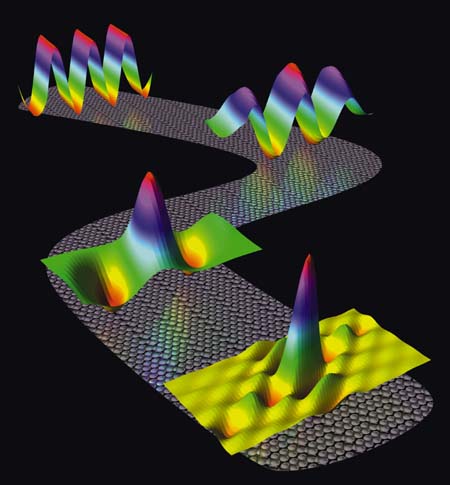 etails about the crucial role of surfaces and interfaces on electron behavior have been veiled behind the blur of dynamic processes occurring on a femtosecond time-scale. (A femtosecond is a millionth of a billionth of a second). The invention of the femtosecond laser in 1982 by Berkeley Lab director Charles Shank gave science the tool needed to lift this veil. Now, more than fifteen years later, Berkeley Lab researchers led by chemist Charles Harris, have used their own brand of femtosecond spectroscopy to give scientists an unprecedented look at what has been hidden from view.
etails about the crucial role of surfaces and interfaces on electron behavior have been veiled behind the blur of dynamic processes occurring on a femtosecond time-scale. (A femtosecond is a millionth of a billionth of a second). The invention of the femtosecond laser in 1982 by Berkeley Lab director Charles Shank gave science the tool needed to lift this veil. Now, more than fifteen years later, Berkeley Lab researchers led by chemist Charles Harris, have used their own brand of femtosecond spectroscopy to give scientists an unprecedented look at what has been hidden from view.
Working with a unique femtosecond laser-based photoelectron spectroscopy system which they designed and assembled, Harris and members of his research group have been able to show how free-moving electrons can cause their own movements to become restricted by trapping themselves on the surface of a crystal. The key to the success of the Harris team is the combination of a femtosecond laser with a high-resolution, time- and angle-resolved spectroscopy technique called "two-photon photoemission (TPPE). They've been using this combination to study the dynamic behavior of electrons at the interfaces of a metal covered with a single layer of non-metal molecules and sealed in a vacuum. A "pump" pulse of laser light, as short as 30 femtoseconds in length, and tunable to a desired wavelength, is shined on the metal to excite or energize an electron, causing it to be emitted into the interface with the non-metal. This photoelectron is then hit with a second "probe" pulse of light, causing it to be emitted out of the metal/non-metal interface and into the vacuum. By recording the photoelectron spectra at different times after each laser pulse and measuring the angles of emission, Harris and his team are able to track the electron and determine to what extent it is "delocalized" (free to roam about) or "localized" (restricted) in its movement.
| Lead scientist on this project
|
|
|
|
|
|
In their latest round of experiments, the Harris team coated a silver surface with a layer of alkane molecules. After the silver was zapped with the pump pulse, the researchers, through the probe pulse, observed that the electrons are initially delocalized so that they move freely through the alkane layer parallel to-but at a fixed elevation above-the surface layer of silver atoms. Within a couple of hundred femtoseconds, however, these electrons become localized within the alkane overlayer as polarons. A polaron is an electron whose interaction with the atoms in a crystal lattice creates a deformation (an energy "well") that traps the electron, like a divot on a fairway can trap a golf ball.
According to Harris, the lattice deformation in which the electron traps itself is caused by small shifts in the positions of positively charged atomic nuclei around the negatively charged electrons. After the passage of more than a thousand femtoseconds, the self-trapped electron is finally able to escape the trap by quantum-mechanically "tunneling" its way back into the metal.
"Our results demonstrate that the ability to both time and angle-resolve the dynamics of electrons at interfaces allows a quantitative determination of the relaxation energies and lattice displacements associated with the small-polaron self-trapping process," says Harris. "Time and angle-resolved TPPE is a powerful probe for 2D electron localization and should be applicable to a wide variety of interfaces."
The experimental results of the Harris team should open the door for future studies that could revolutionize the understanding of electron dynamics at surfaces and interfaces. This, in turn, could pave the way for molecular electronics, organic light-emitting diodes, electricity-conducting plastics, and even the long-sought but so far elusive flat-screen television.
- Lynn Yarris



 etails about the crucial role of surfaces and interfaces on electron behavior have been veiled behind the blur of dynamic processes occurring on a femtosecond time-scale. (A femtosecond is a millionth of a billionth of a second). The invention of the femtosecond laser in 1982 by Berkeley Lab director Charles Shank gave science the tool needed to lift this veil. Now, more than fifteen years later, Berkeley Lab researchers led by chemist Charles Harris, have used their own brand of femtosecond spectroscopy to give scientists an unprecedented look at what has been hidden from view.
etails about the crucial role of surfaces and interfaces on electron behavior have been veiled behind the blur of dynamic processes occurring on a femtosecond time-scale. (A femtosecond is a millionth of a billionth of a second). The invention of the femtosecond laser in 1982 by Berkeley Lab director Charles Shank gave science the tool needed to lift this veil. Now, more than fifteen years later, Berkeley Lab researchers led by chemist Charles Harris, have used their own brand of femtosecond spectroscopy to give scientists an unprecedented look at what has been hidden from view.
